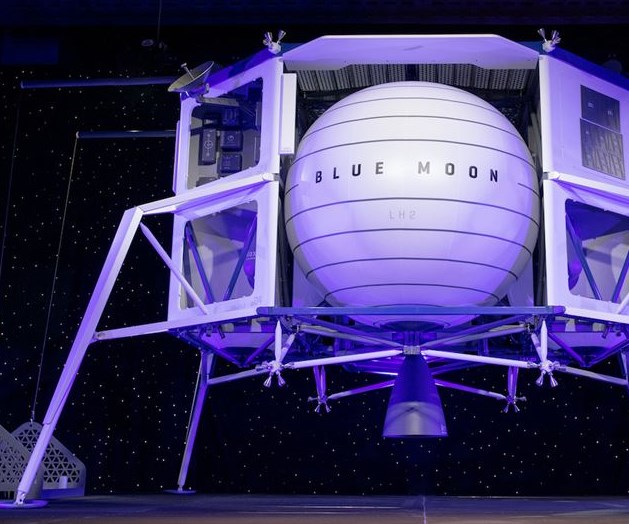Blue Origin to team up with Lockheed Martin, Northrop Grumman and Draper on lunar lander
Proposed lunar landing system to be considered for NASA’s Artemis program, which seeks to return humans to the moon by 2024.

Source | Blue Origin
Jeff Bezos, founder of Blue Origin (Kent, Wash., U.S.), on Oct. 22 at the 70th International Astronautical Congress in Washington, D.C., U.S., announced that the company would partner with Lockheed Martin (Bethesda, Md., U.S.), Northrop Grumman (Falls Church, Va., U.S.) and Draper (Cambridge, Mass., U.S.) on a lunar landing system that could be used for NASA’s Artemis program which seeks to return humans to the moon by 2024. NASA announced in September it is seeking proposals for human lunar landing systems designed and developed by American companies for the program.
The proposed lunar landing system will comprise Blue Origin’s Blue Moon lunar lander, a “Transfer Element” vehicle provided by Northrop Grumman (Falls Church, Va., U.S.) that will position the landing system in lunar orbit, and an “Ascent Element” vehicle provided by Lockheed Martin that will return astronauts to lunar orbit from the Moon’s surface. A descent guidence system and flight avionics will be provided by Draper.
Blue Origin’s Blue Moon lunar lander is reportedly capable of delivering multiple metric tons of payload to the lunar surface based on configuration and mission. It is powered by the company’s new BE-7 engine, which is designed for large lunar payload transport and reportedly delivers 40 kN (10,000 lbf) of thrust using a combination of liquid oxygen and liquid hydrogen propellants.
Related Content
-
Infinite Composites: Type V tanks for space, hydrogen, automotive and more
After a decade of proving its linerless, weight-saving composite tanks with NASA and more than 30 aerospace companies, this CryoSphere pioneer is scaling for growth in commercial space and sustainable transportation on Earth.
-
PEEK vs. PEKK vs. PAEK and continuous compression molding
Suppliers of thermoplastics and carbon fiber chime in regarding PEEK vs. PEKK, and now PAEK, as well as in-situ consolidation — the supply chain for thermoplastic tape composites continues to evolve.
-
ASCEND program update: Designing next-gen, high-rate auto and aerospace composites
GKN Aerospace, McLaren Automotive and U.K.-based partners share goals and progress aiming at high-rate, Industry 4.0-enabled, sustainable materials and processes.
















